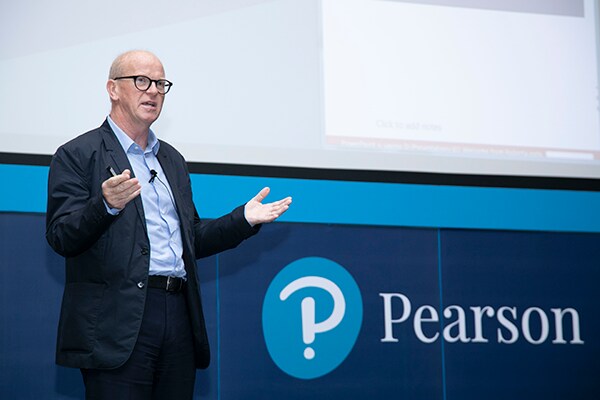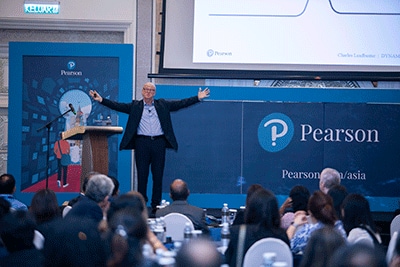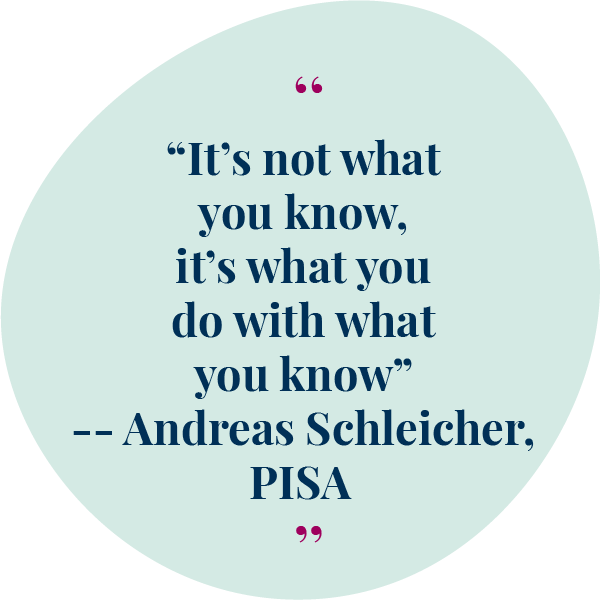Disrupting Education Systems to Develop a New Generation of Problem Solvers

Technology has revolutionised the world. With automation, artificial intelligence and digital technology pervades our everyday lives, the key question to ask is: How do we prepare our learners for a future world governed by technology? At Pearson’s conference on “Growing Global Education Now!” held at Kuala Lumpur in October, educators from across South and Southeast Asia heard from global education consultant, Mr. Charles Leadbeater, how to lead the way into a global learning movement.
Learning to be better humans
“The future is going to be vastly different from what we have now. We will see traditional jobs undergoing a radical upheaval in the next 10 years. Some jobs are slowly disappearing while others will require different types of skills or processes to work with technology,” Leadbeater explains.
He expounds on the danger in our education systems where young people are taught to learn by routine, where they follow instructions and process information, then regurgitate the knowledge in examinations in order to get the grades required.
“That is going to leave young people in the dead end because, in the future, any activity which requires the processing of lots of data will see robots and artificial intelligence outperforming humans. What we have to do is to develop young people who will be better humans,” he theorizes.

The future comes with no instruction manual
Leadbeater states that if education is going to prepare learners for the future, it needs to shift from a model of “following instructions” to one of “solving problems”.
In conducting the research for his book, The Problem Solvers, Leadbeater visited innovative and progressive schools all over the world who have applied unique models of teaching and learning. While their curriculums are dissimilar to one another, he found one common thread among them: dynamic education which incorporates exposure to the real world while also developing the holistic aspects of each learner.
“Preparing young people to be creative problem solvers requires a combination of old and new methodologies. The most impressive schools that I go to are a mixture of the very new -- progressive techniques and digital technologies -- and the very old -- methodologies to build character, personal strengths, entrepreneurship and outward learning,” he says.
However, he warns educators against the common trap of falling prey to false dichotomies that divide between knowledge and skills, theory and action, traditional and progressive or digital and real-world learning.
The dynamics of learning
Leadbeater explains that dynamic learning is an experience of a structured, yet active kind of learning that gives learners the experience that they take into the world. “My hypothesis of dynamic learning is that it has four critical elements. Young people should be equipped with a combination of knowledge, personal strengths, social skills and a capacity for agency. When you go to good schools and you see good teachers, what they’re doing is designing and orchestrating the dynamic combinations of these four ingredients,” he informs.

Firstly, knowledge, which forms the foundation of learning. The journey into knowledge starts with the basic skills of literacy and numeracy, moves on to the knowledge of core content and even further into higher-order concepts and thinking skills to challenge, question and adapt existing knowledge.
Leadbeater states that while the basic building blocks of knowledge help learners to know about the world around them, it is more crucial to have a theory of knowledge. He emphasised that it is the ability to discern, analyse, research, think critically and combine different disciplines of knowledge that becomes the basis for creative problem-solving.
The second element acknowledges that education needs to be a personal journey of growth and discovery. This focuses on developing personal attributes of character that will count later on in life.

“Qualities such as growth, resilience, persistence and purpose are just as important as knowledge if young people want to thrive and succeed in the real world. Not only do they need to learn how to be resilient and adaptive, but they will also need to have a clear sense of purpose, to know the difference they want to make and the value they want to add to the world,” Leadbeater shares.
The third element covers social skills where learners are encouraged to deepen their relationships with other people by learning how to connect, communicate and collaborate in order to achieve things together.
This involves methods which facilitate collaboration between learners, such as getting them to work together in groups on a certain project or problem. The process would involve dialogue and discussion, as well as tapping on the diverse skills and outlooks of the different members of the group. This is where the skills of collaboration come in handy, something which cannot be effectively taught in the classroom.

The last element, agency, is the route to take action, primarily to make a contribution to the world by helping other people. Agency is the true test of learning, where learners turn knowledge and ideas into action in order to make a difference to the world. The way that this can be done is by incorporating projects like making things, running a business or serving the community.
“In order to get the students to be really interested, find something real that matters to them. The need for learning is stronger if it makes a difference to someone else. For example, one of the schools I visited in Spain asked students to build houses for refugees. They were able to take responsibility for their own learning and integrating knowledge from multiple disciplines such as science, economics, geography, language and technology,” Leadbeater says.

Making the shift
In introducing these four elements of dynamic learning, how can they be effectively applied in schools to create a more dynamic education system? Leadbeater explains that it would require the combination of dynamic teachers, dynamic curricula and dynamic methods of assessment.
“Several countries like Canada, Australia, Singapore and Hong Kong have already led the way in developing hybrid curricula which foster a mix of skills. More critically, we need to shift the focus of assessments on knowledge to an assessment of skills that students need to acquire to succeed. Dynamic learning requires dynamic forms of assessment which involve both formative and summative, online and in action, in the exam hall and in the real world,” he shares.
To overcome the challenge of implementing this on a larger scale, Leadbeater urges educators to be an active participant of this global learning movement.
He concludes by saying, “Education is not just about gaining knowledge and getting the grades. It is about building young people who can make a difference for our world. We must prepare them for an uncertain future, which is open and full of possibilities but also facing deep and urgent challenges that need to be addressed. We want to create a generation of problem solvers who excel at being human and come with the human capacity to care, to empathise and to create.”
To continue the conversation on Dynamic Learning please join the International Schools Community. If you would like further information on qualifications resources to support your classroom please visit us here.
read more

